Maxillomandibular Relations Long Essays
Question 1. Define vertical jaw relation. Enumerate the different methods to register the vertical jaw relation. Describe any one method in detail.
(or)
Question 1. Define jaw relation and explain various methods involved in recording vertical jaw relation.
(or)
Question 1. Discuss various methods of determining vertical dimension in edentulous patients. Describe anyone.
(or)
Question 1. Define vertical jaw relation. Explain in detail the various techniques of recording it.
Or
Methods of recording vertical dimension.
Answer:
Maxillomandibular Relations Long Essays
Maxillomandibular Relations Definition:
- Jaw Relation: Any relation of the mandible to the maxilla
- Vertical Jaw Relation:
- The length of the face as determined by the amount of separation of the jaws
- Methods for recording vertical jaw relation
Read And Learn More: Prosthodontics Question And Answers
Methods Of Recording Of Vertical Jaw Relations:
1. Methods To Measure Vertical Jaw Relation At Rest:
- Facial Measurements:
- Two reference points are marked
- One on the nose and other over the chin
- The patient is asked to perform various functions Distance between the two reference points is measured
- This gives a measurement of the physiological rest position of the mandible.

- Facial Expression:
- The patient is asked to relax
- Various expressions are viewed
- Anatomical Landmarks:
- Distance between:
- Pupil of the eye and corners of the mouth
- Anterior nasal spine and lower border of the mandible
- Anatomical Landmarks is measured
- If they are equal, jaws are at rest
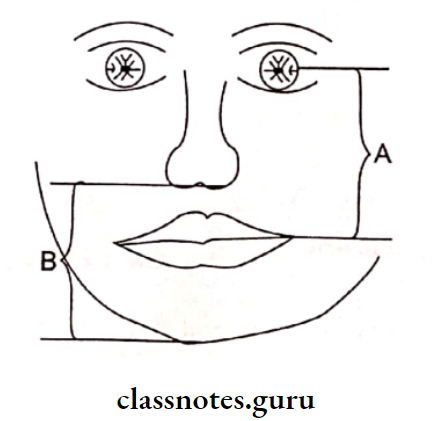
- Tactile Sensation:
- The patient is asked to open the mouth wide
- Then close his mouth slowly till the muscles are relaxed
- Distance between two reference points is measured
- Speech:
- The patient is asked to repeat the letter ‘m’
- Distance between two reference points is measured as soon as the patient stops repeating
Centric Relation in Complete Dentures Essay
2. Vertical Jaw Relations At Occlusion:
- Ridge Relation:
- Distance between incisive papilla to mandibular incisors is measured distance be-tween incisive papilla & maxillary incisors is 6 mm
- Overbite is 2 mm
- Thus, the distance between the incisive papilla & mandibular incisors is 4 mm
- Ridge Parallelism: Mandible is parallel to maxilla only at occlusion
- Distance between incisive papilla to mandibular incisors is measured distance be-tween incisive papilla & maxillary incisors is 6 mm

- Pre-extraction Records:
- Profile photographs
- Profile silhouettes
- Radiography
- Articulated cast
- Facial measurements
- Measurements from former dentures:
3. Physiological Methods:
- PowerPoint: By Boos
- A metal central bearing plate is attached to the upper base
- Bimeter attached to lower base
- Inserted in patient’s mouth & asked to bite
- Pressure reading in bimeter is recorded

- Using Wax Occlusal Rims:
- Measure vertical relation at rest
- Estimate vertical relation to be 2-5 mm less of it
- Coat occlusal surface of maxillary rim with petrolatum
- Place triangular sectioned occlusal rim over the mandibular rim
- Soften the wax
- Ask the patient to bite over it
- Remove it and articulate
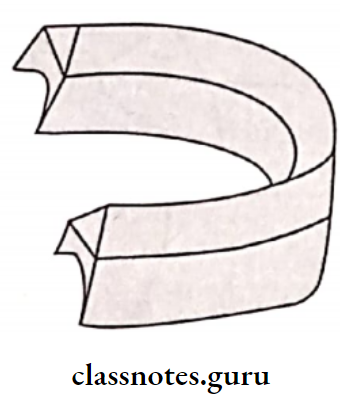
- Physiological Rest Position (Niswonger And Thomson):
- Seat the patient
- Ask him to swallow and relax
- Part the lips slightly
- Space exists between the upper and lower rims
- This space is called “Freeway space”
- It should be 2-4 mm
- By it, vertical dimensions at occlusion is calculated from the formula
- VD at rest =VD at occlusion + freeway space
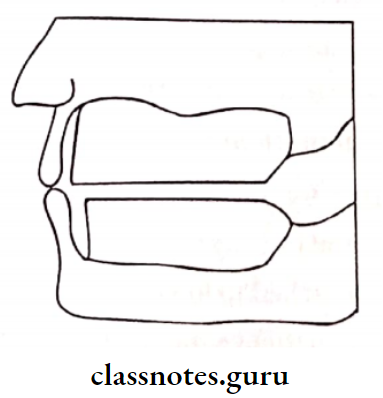
Vertical Dimension of Occlusion in Prosthodontics
Then a+b+c. The vertical dimension at rest is equal to the sum of the vertical dimension at occurrence and free way space

- Phonetics:
- Silverman’s closest speaking space:
- Sounds like ch, s, j results in the closest relation of upper and lower rim without contacting each other
- This indicates the vertical dimension of the patient
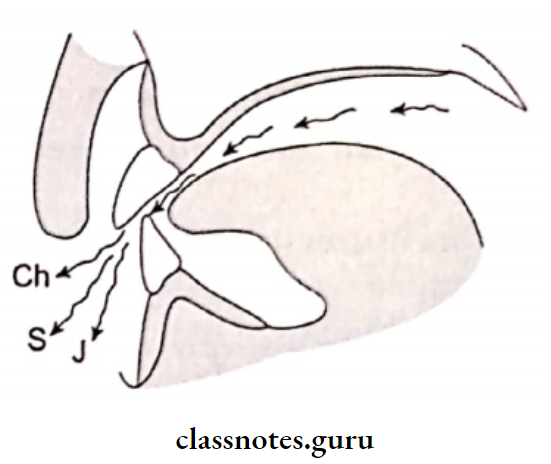
- Aesthetics:
- The size of teeth assessed from the residual ridge resorption
- Swallowing Threshold:
- The conical rim is placed over the lower rim
- Insert both the record bases
- Ask the patient to swallow
- By this height of the lower rim is reduced
- Tactile Sensation:
- Occlusal rims with a central bearing plate & screw are inserted in the patient’s mouth,
- Tighten the screw till the patient feels discomfort

- A – Tactile sense method of determining vertical jaw relation vertical jaw relation
- B – Central bearing point
- C – Central bearing plate
- Patient’s Perception:
- Occlusal rims with excessive height is inserted in the patient’s mouth
- Stepwise reduction is carried out till the patient feels comfortable
Long Essay on Jaw Relations in Complete Dentures
Question 2. Define balanced occlusion. Discuss in detail the factors affecting balanced occlusion in complete dentures.
Or
Define balanced occlusion. Write in detail about various factors affecting it.
(or)
Define balanced occlusion. Explain its significance. Write in detail about various factors affecting it.
Or
Factors affecting balanced occlusion.
Answer:
Balanced Occlusion Definition:
“The simultaneous contacting of the maxillary & mandibular teeth on the right & left & in the anterior & posterior occlusal areas in centric & eccentric positions, developed to lessen or limit tipping or rotating of the denture bases concerning the supporting structures
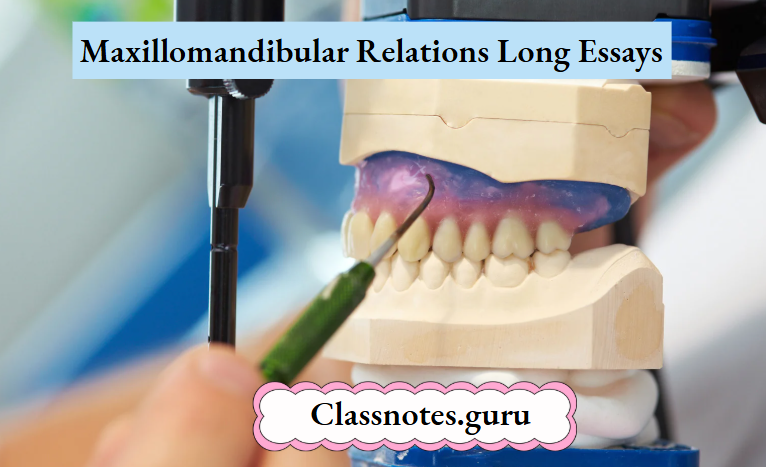
Factors Affecting Balanced Occlusion:
1. Condylar Guidance:
- The first factor of occlusion to be considered
- Measured using protrusive registration
- Increased condylar guidance increases jaw separation
- It cannot be modified

2. Incisal Guidance:
- “The influence of the contacting surfaces of the mandibular & maxillary anterior teeth on mandibular movements”
- The second factor of occlusion
- Customized
- If overjet increases, it decreases
- If overbite increases, it increases
- If incisal guidance is steep, steep cusps, steep occlusal plane & steep compensatory curves are required
- It must be as flat as possible
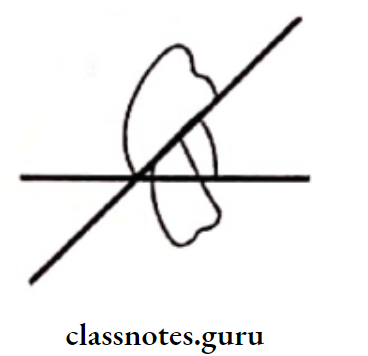
3. Occlusal Plane:
- “An imaginary surface which is related anatomically to the cranium & which theoretically touches the incisal edges of the incisors & the tips of occluding surfaces of posteriors”
- Height of the lower canine should coincide with a measure of the mouth
- It should not be altered beyond 10°
- A posterior plane parallel to the Camper’s line 10°
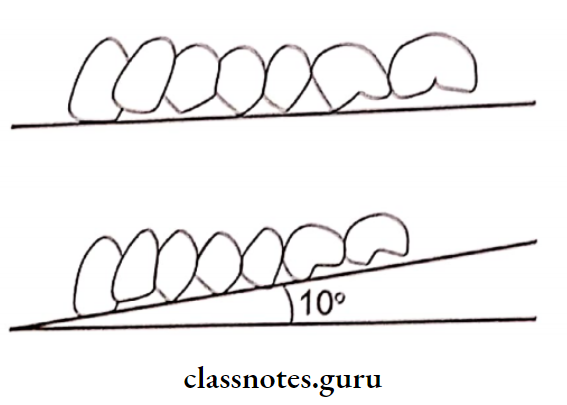
4. Cuspal Angulation:
- “The angle made by the average slope of a cusp with the cusp plane measured mesiodistally or buccolingually”
- Reduced cuspal height in shallow overbite High cuspal angle in deep bite

5. Compensatory Curves:
- “The anteroposterior & lateral curvatures in the alignment of the occluding surfaces & incisal edges of artificial teeth which are used to develop balanced occlusion
- Steep compensatory curves for steep condylar path
- Shallow curves for loss of balancing molar contacts
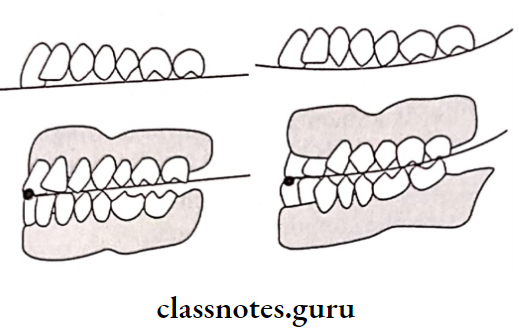
- Thus balance must be present between all the five factors
- Effect of incisal & condylar guidance must counter-act by the effect of other three factors
- If the balance is lost, balanced occlusion cannot be achieved
Question 3. Define Centric relation. Classify jaw relation. Write in detail on any one technique of determining jaw relation.
Or
Define centric jaw relation. Classify different methods & explain any one method for recording jaw relation.
Or
Methods of centric jaw relation.
Answer:
Centric Jaw Relation:
The maxilla mandibular relation in which the condyles articulate with the thinnest avascular portion of their respective disc with the complex in the anterior-superior position against the slopes of the articular eminence
Jaw Relations And Methods To Record Them:
Orientation jaw relation: by face bow: Vertical jaw relation:
- Vertical jaw relation at rest:
- Facial measurement
- Tactile sense
- Measurement of anatomical landmarks
- Speech
- Facial expression
- Vertical Jaw Relation At Occlusion:
- Mechanical methods:
- Ridge relation
- Ridge parallelism
- Distance of incisive papilla to mandibular Incisors
- Ridge relation
- Pre-extraction records
- Mechanical methods:
- Physiological Methods: [PATUS]:
- Powerpoint
- Physiological rest
- Phonetics
- Patient’s perception
- Aesthetics
- Tactile sense
- Using wax records Swallowing threshold
- Horizontal Jaw Relation:
- Physiological methods –
- Tactile method
- Pressureless method
- Pressure method
- Functional method:
- Needlehouse method
- Patterson method
- Graphic method:
- Intraoral
- Extraoral
- Radiographic method
- Physiological methods –
Pressureless Method [Nick And Notch]:
Seat the patient in an upright position
↓
Retrude his mandible
↓
Remove up to 3 mm of wax from either side of the mandibular rim
↓
Cut 1-2 notch on the corresponding area of the maxillary rim
↓
Make a nick anterior to it [notch-prevent anterioposterior movement Nick-lateral movement]
↓
Add aluwax upto 4.5 mm in mandibular rim & insert in patient’s mouth Teach the patient to close mouth in centric relation
↓
Remove the rims & place it in cold water
↓
Check for any errors
↓
Articulate it.
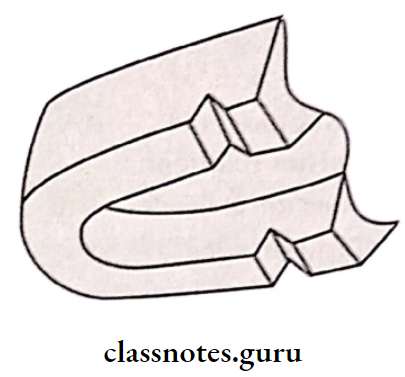
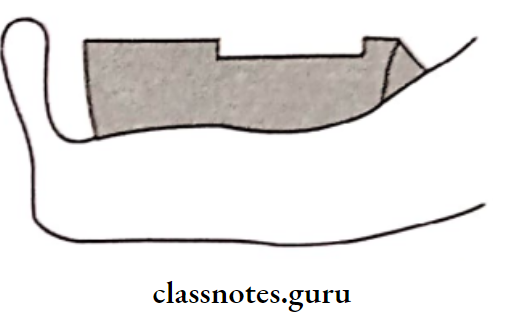
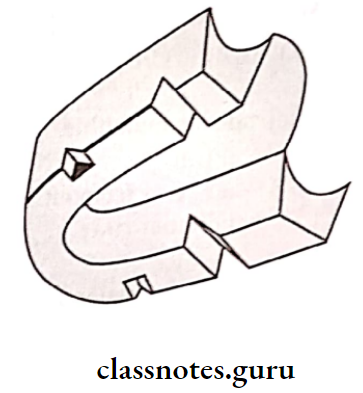
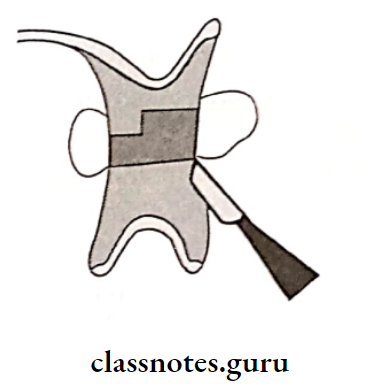
Question 4. Classify Jaw and Centric relation. Explain its significance. What are the methods for recording it.
Or
Classification Of Jaw Relation
Answer:
Jaw Relations:
Any relation of the mandible to the maxilla
Jaw Relation Classification:
- Orientation Jaw Relation:
- The jaw relation when the mandible is kept in its most posterior position, it can rotate in the sagittal plane around an imaginary transverse axis passing through or near the condyles’
- Verticle Jaw Relations: The length of the face as determined by the amount of separation of the jaws
- Vertical Relation At Rest:
- The length of the face when the mandible is in rest position
- Vertical Relation At Occlusion:
- The length of the face when the teeth are in contact & the mandible is in centric relation or the teeth are in centric relation
- Vertical Relation At Rest:
- Horizontal Jaw Relation: It is the relationship of the mandible to the maxilla in the horizontal plane
Prosthodontics Essay on Maxillomandibular Relations
Centric Jaw Relation:
The maxillomandibular relation in which the condyles articulate with the thinnest avascular portion of their respective disc with the complex in the anterior-superior position against the slopes of the articular eminence
Centric Jaw Relation Significance:
- Proprioceptive impulses guide the mandible during various movements
- In edentulous patients, it is possible from the impulses of PDL
- But in edentulous patients, it is not possible
- In such cases, impulses are received from our transferred to TMJ
- Centric relation acts as a center for such impulses
- It guides the mandible during such movements
Centric Jaw Relation Methods Of Recording It:
1. Physiological Methods:
- Tactile Method:
- Ask the patient to retrude the mandible
- Tentative jaw relation is recorded
- Based on it casts are articulated
- Teeth arrangement is done
- Pressureless Method:
- Occlusal rims are fabricated
- Denture base along with occlusal rim is inserted in the patient’s mouth
- Ask the patient to close in a centric relation
- Occlusal rims are sealed in this position
- Pressure Method:
- Upper occlusal rim is inserted into the patient’s mouth
- The lower rim is fabricated with excess material
- It is thoroughly softened and inserted in the mouth
- Ask the patient to close in centric relation over softened wax
2. Centric Jaw Relation Functional Method:
- Centric Jaw Relation utilizes the functional movements of the jaw to record centric relation
- Needlehouse method
- Patterson method
3. Centric Jaw Relation Graphic method:
- Centric Jaw Relation involves tracing to record centric jaw relation
- Intraoral
- Extraoral
4. Centric Jaw Relation Radiographic Method
Question 5. Define balanced occlusion. Give in detail its various functional objectives in complete dentures.
Answer:
Balanced Occlusion Definition:
The simultaneous contacting of the maxillary & mandibular teeth on the right & left & in the anterior &posterior occlusal areas in centric & eccentric positions, developed to lessen or limit tipping or rotating of the denture bases in relation to the supporting structures
Balanced Occlusion Functional Objectives:
- The smaller the area of the occlusal surface, the lesser the transmission of forces to the supporting structures
- A tilted occlusal surface causes, nonvertical forces on the denture
- Tilted tissue support causes nonvertical forces on the denture
- Vertical forces on resilient tissues cause lever forces on the denture
- Vertical forces outside the ridge cause tipping of the denture
- The stability of the denture must be present in both centric & eccentric relation
- Balanced occlusal contacts during eccentric movements Unlocking of cusps to settle the denture
- Reduced cuspal height to resist horizontal forces Efficient mastication efficiency
- Minimal tooth contact during mastication
- Absence of sharp ridges & cusps
- Wide & large ridges
- Teeth arranged close to ridge Narrow ridge rest on ridge
- Arrangement of teeth slight lingually Forces of occlusion should be centered

Question 6. Discuss the importance & validity of centric relation.
Or
Significance of centric relation.
Answer:
Centric Relation Importance:
- Proprioceptive impulses guide the mandible during various movements In edentulous patients it is possible from the impulses of PDL
- But in edentulous patients, it is not possible In such cases, impulses received from the ridge are transferred to TMJ
- Centric relation acts as a center for such impulses
- Centric Relation guides the mandible during such movements
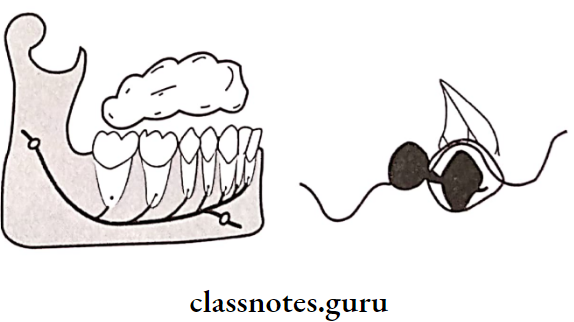
Centric Relation Validity:
- Learnable
- Repeatable
- All functional movements are possible from this position
- The arrangement of muscles is such that they move the mandible from a centric position
- Helps in the mounting of casts
- Adjustment of condylar guidance in articulator is done according to it
- Definite
- Recordable
- During any movement of the mandible, it has passed from this position first
Question 7. Mention the significance of physiologic rest position
Or
Physiologic rest position and Discuss effects of increased & decreased vertical jaw relations.
Answer:
1. Significance Of Physiological Rest Position:
- “The mandibular position assumed when the head is in an upright position & the involved muscles, particularly the elevator & depressor groups, are in equilibrium in tonic contraction, and the condyles are in a neutral, unstrained position”
- During rest position, space exists between the upper & lower rims
- This is called freeway space
- It should be 2-4 mm
- If it increases, the vertical dimension at occlusion re- duces & becomes inefficient
- If this space decreases, then the vertical dimension at occlusion increases to a greater extent
- This increases lower facial height of the patient
2. Effects of Increased Vertical Dimensions:
- Increased trauma to the denture-bearing area
- Increased lower facial height
- Cheek biting
- Difficulty in swallowing & speech
- Pain & clicking in TMJ
- Stretching of facial muscles
- Increased space of the oral cavity
3. Effects Of Decreased Vertical Dimensions:
- Decreased trauma to the denture-bearing area
- Decreased lower facial height
- Angular cheilitis
- Difficulty in swallowing
- Pain, clicking & discomfort in TMJ
- Loss of lip fullness
- Loss of muscle tone
- Dropping down of corner of the mouth
- Thinning of vermillion borders of lip
- Decreased space of the oral cavity
